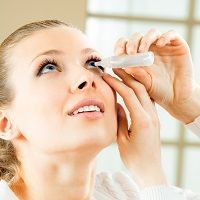Article
Dry Eye Disease Associated with Visual Display Terminal Use
Author(s):
Data show visual display terminal use causes dry eye disease mainly through impaired blinking patterns.

Visual display terminal (VDT) use has been linked to more incomplete blinks and decreased blink rates, triggering pathophysiological mechanisms that promote the development of dry eye disease (DED), according to new findings.
An increase in exposure of the tear film and decreased meibum distribution could cause an increase in tear film instability and ocular surface stress, while the possible harmful effects of blue light may lead to DED development.
“Although not sufficiently studied, inadequate blinking may lead to altered parasympathetic signaling to the lacrimal gland and goblet cells and reduced secretion,” wrote study author Ketil Fjærvoll, University of Oslo. “Combined with possible harmful effects of blue light, these changes may disrupt tear film homeostasis and promote DED development.”
An important risk factor for DED, the use of VDT reduced blink rates and tear film break-up time (TBUT), leaving the ocular surface more exposed. As a result of the digital age, the use of VDT has become ubiquitous and disorders related to sedentary behaviors and VDT are prevalent.
The current review investigated the possible pathophysiological mechanisms behind DED development in VDT users and areas of focus necessary in future research. Investigators performed a literature search in PubMed using the search terms “computer OR smartphone OR display terminal OR screen use” and “dry eye OR DED.”
A total of 55 articles were included in the review that assessed dry eye signs or symptoms in VDT users that could provide useful pathophysiological insights.
Investigators noted reduced blink rates and more incomplete blinks during VDT use was the most frequently suggested pathway on how VDT promotes dry eye. From 49 studies that mentioned these mechanisms, five proposed incomplete blinking as the main contributor to harmful consequences.
Further, 2 studies hypothesized that VDT use caused DED signs and symptoms through suppression of parasympathetic stimulation and reduced lacrimal gland secretion, while another 3 articles mentioned the ocular toxicity of blue light exposure.
These proposed mechanisms lead to increased tear film instability, exposure and evaporation, caused by reduced lacrimal gland function, decreased blink rate, increased incomplete blinking, and reduced mucin secretion.
Additionally, it was noted that the use of VDT devices reduces TBUT and increases interlink intervals (IBI), leading to a substantial decrease in the ocular protection index (OPI). An increase in cognitive demand and the gathering of visual information during VDT use reduces blink rates and promotes incomplete blinking, which is additionally linked to reductions in ocular lubrication and increased friction.
Further, a change in aqueous layer and lacrimal gland function could contribute to DED in VDT use, but it required further investigation. They noted that both the disruption of lacrimal gland morphology and the accumulation of secretory vesicles may be signs of disturbance of parasympathetic innervation of the gland.
Moreover, blue light can be harmful to the epithelial cells on the ocular surface and reduce visibility, proliferation and migration of human corneal epithelial cells. Investigators noted patients with DED could be particularly sensitive to blue light, as preexisting hyperosmolar stress has been shown to increase the ocular toxicity of blue light.
A reduced blink rate during VDT use was suggested to cause stagnant meibum to build up and block the meibomian glands, while incomplete blinks are slower than complete blinks and create less driving force, reducing the secretion of the meibum.
“More studies are needed to further illuminate the pathways involved and find appropriate preventive measures for VDT-associated DED,” Fjærvoll concluded.
The study, “Review on the possible pathophysiological mechanisms underlying visual display terminal-associated dry eye disease,” was published in Acta Ophthalmologica.





